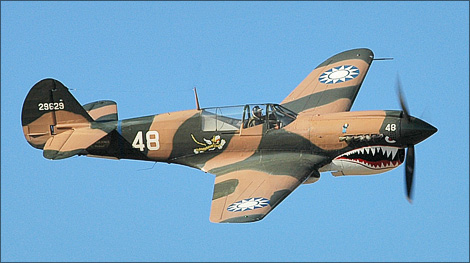Curtiss P-40
Warhawk
(Variants/Other Names: Model 81; Tomahawk;
Kittyhawk)

(Image by Max Haynes -
MaxAir2Air.com.)
History: The P-40 fighter/bomber was the
last of the famous "Hawk" line produced by Curtiss Aircraft in the 1930s and
1940s, and it shared certain design elements with its predecessors, the Hawk and
Sparrowhawk. It was the third-most numerous US fighter of World War II. An early
prototype version of the P-40 was the first American fighter capable of speeds greater
than 300 mph. Design work on the aircraft began in 1937, but numerous experimental
versions were tested and refined before the first production version of the P-40, the Model
81, appeared in May 1940. By September of that year, over 200 had been
delivered to the Army Air Corps. 185 more were delivered to the United Kingdom in the fall
of 1940, where they were designated the Tomahawk Mk I.
Early combat operations pointed to the need for more armor
and self-sealing fuel tanks, which were included in the P-40B
(called the Tomahawk Mk IIA in the UK). These improvements came
at price: a significant loss of performance due to the extra weight. Further armor
additions and fuel tank improvements added even more weight in the P-40C
(Tomahawk Mk IIB). Curtiss addressed the airplane's mounting
performance problems with the introduction of the P-40D (Kittyhawk
Mk I), which was powered by a more powerful version of the Allison V-1710
engine, and had two additional wing-mounted guns. The engine change resulted in a slightly
different external appearance, which was the reason the RAF renamed it from the Tomahawk
to the Kittyhawk. Later, two more guns were added in the P-40E (Kittyhawk
Mk IA), and this version was used with great success (along
with their mainstays, the earlier B-models) by General Claire Chenault's American Volunteer Group (The Flying Tigers) in China.
Some additional models, each with slight improvements in
engine power and armament, were the P-40F (with a 1300 hp
Rolls-Royce Merlin engine), the P-40G, P-40K
(Kittyhawk Mk III), P-40L, P-40M
and finally, the P-40N, of which 5200 were built (more than any
other version.) While it was put to good use and was certainly numerous in most theaters
of action in WWII, the P-40's performance was quickly eclipsed by the newer aircraft of
the time, and it was not considered one of the "great fighters" of the war.
Nicknames: Gipsy Rose Lee (UK
nickname for the P-40L)
Specifications: (P-40N):
Engine: 1360hp Allison V-1710-81 inline piston engine
Weight: Empty 6,000 lbs., Max Takeoff 11,400 lbs
Wing Span: 37ft. 4in.
Length: 33ft. 4in.
Height: 12ft. 4in.
Performance:
Maximum Speed at 10,000ft: 378mph
Ceiling: 38,000ft
Range: 840 miles (with no external
tanks)
Armament:
Six 12.7mm (0.5-inch) wing-mounted
machine guns
Up to 1,500lbs of bombs on three wing
hard-points
Number Built: Approximately 15,000
Number Still Airworthy: 29
Cockpit Photo (P-40N N49FG):

(Click for larger)
Links:
AeroWeb P-40
Reference Page
Debut of the
Only Flyable P-40C (Restoration) (From The Planes and Pilots of WWII site.)
Flying Tigers: American Volunteer Group
(Official Site)
Flying Tigers' P-40 Pilot's Manual online
Operating
Instructions for the P-40N-20
P-40.com -- A good starting point for P-40
research.
Pioneer Aero Restorations, Auckland, New
Zealand -- Award-winning restorations of P-40s.
Rudy Frasca's P-40
(360-degree panoramic cockpit photo)
The Hawk's Nest -- P-40 information
and photos
USAF Museum P-40 Page
USAF Museum P-40 Research

[ Click here for more great books
about the P-40! ]

[Back to Warbird Alley's Main
Page]
All text and photos Copyright 2016 The
Doublestar Group, unless otherwise noted.
You may use this page for your own, non-commercial reference purposes only.
 |